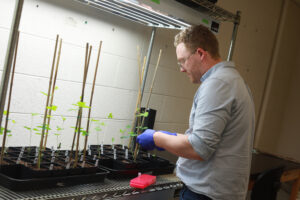Harrison Miles fills six plastic cylinders with pieces of leaves from a soybean plant. He slips them inside a machine that resembles a kitchen blender and sets it awhirl. The vials spin so quickly they need time to cool before he begins his next task – extracting the RNA he’ll use for further investigation.

“We create a soup of the fungus,” said Miles, who earned a degree in psychology and elementary education from the University of Mary Washington in 2015, and returned to campus to study conservation biology. “I knew I wouldn’t be able to get this kind of experience anywhere other than Mary Washington.”
Working on Jepson Science Center’s third floor, he spent the summer working with beauveria bassiana harvested from spotted lantern flies shipped in from Pennsylvania. He injected the fungus into soybeans and measured toxin production as the plants grew. The work, done with guidance from Assistant Professor of Biological Sciences Josephine Antwi, could help create more effective organic pesticides.
The project is one of more than a dozen that unfolded during the University’s 24th annual Summer Science Institute (SSI), focused on biology, chemistry, computer science, Earth and environmental sciences, physics and math. The 10-week event had students and faculty working closely together on research aimed at finding solutions to real-world concerns, like pesticides.
A public symposium, featuring posters and oral presentations, will showcase the results on Wednesday, July 19, from 9 a.m. to 4:30 p.m., at the Hurley Convention Center’s Digital Auditorium. A scholarship contributed by 1961 Mary Washington alumna Dr. Jerri Barden Perkins ’61, will be awarded to the best oral and poster presenters.
“SSI is an unparalleled experience for students interested in making contributions to STEM research,” said Associate Professor of Mathematics Randall Helmstutler, who co-chairs the institute with Associate Professor of Chemistry Davis Oldham. “The students are able to apply and extend their knowledge acquired in the classroom to real, relevant problems in their field.”
The program – which received funding from the Naval Surface Warfare Center, Dahlgren Division – provides access to extensive research not easily folded into the academic year, Oldham said. “And working full time with a faculty member gives students valuable insight into the daily life of a scientist.”
For Assistant Professor of Biology Ginny Morriss’ students, that meant using fruit flies to study a progressive disease called myotonic dystrophy and how it affects the signaling pathways in muscles. Professor of Mathematics Leo Lee’s students solved equations, wrote algorithms and designed computer programs to make predictions about the course of pandemics like COVID-19.
Assistant Professor of Earth and Environmental Sciences Pamela Grothe took students Jessica Oberlies and Jacob Cantor on a “trip of a lifetime,” she said. They traveled to Kiritimati Island, planning to collect samples of ancient corals for research on climate change, El Niño patterns and coral reef health. The excursion, funded by Grothe’s National Science Foundation Research Opportunity Award, was a collaboration with universities like Brown and Florida State.
“The Summer Science Institute provides UMW students equivalent research opportunities usually only found at large research-based universities,” Grothe said. “It makes them more competitive when applying for graduate schools.” And thanks to a recent $30 million gift from alumna Irene Piscopo Rodgers – the largest in the University’s 115-year history – funding for undergraduate research in STEM fields is expected to grow.
In both the Summer Science Institute and a sister program, the Arts, Humanities, and Social Sciences Summer Institute, undergraduates work alongside faculty to conduct professional-level research, analyze data and present their findings. And in both institutes, student researchers receive room, board and a stipend.
Professor of Physics Matthew Fleenor, junior Carter Bussey and senior Jason Walker teamed up with the Space Telescope Science Institute to help further the field of astrophysics. The trio used the Skynet Robotic Telescope Network and set to work processing hundreds of images to help identify star-forming regions inside our galaxy and possible planets outside our solar system.
“The skills used in astrophysics research – model building, experimentation and troubleshooting – are the same in the workplace and other branches of science,” Fleenor said. “SSI provides formative experiences for students who not only want to continue their studies but also want to go on to meaningful work.”





